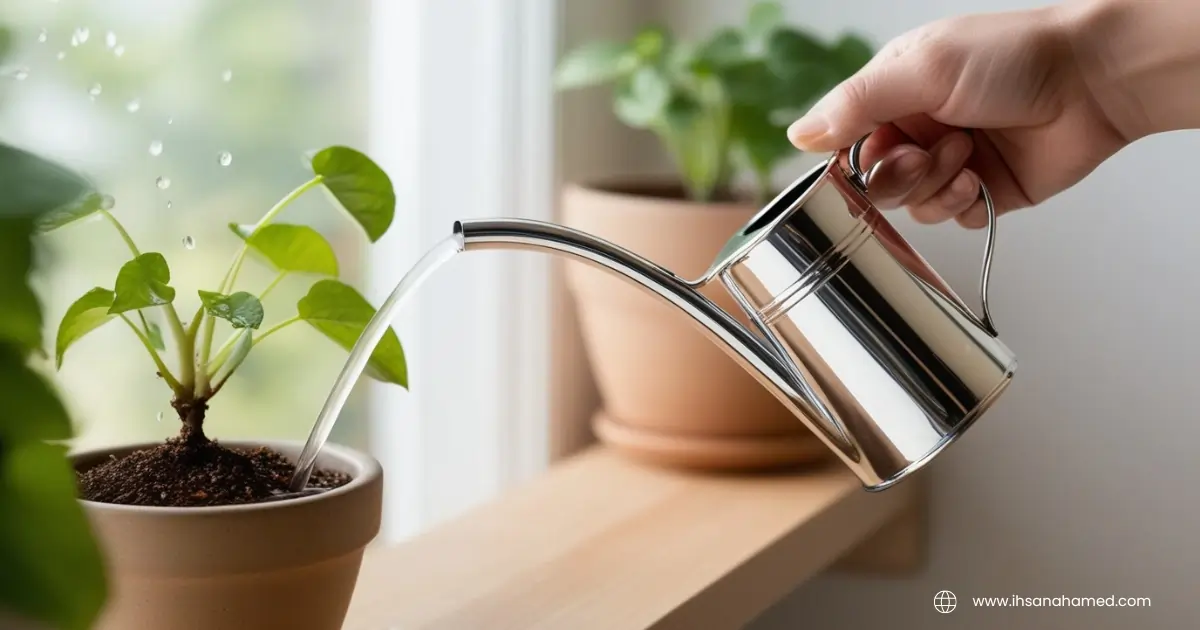1. How Do You Effectively Manage Watering Indoor Container Vegetables?

You can control the environment of lighting, water, and temperature of the plant indoors more easily than outdoors. But whereas outdoors is good for nature it faces real-world challenges in winds and sudden climate changes.
Light and Water Management
Most homes do not get enough sunlight and use grow lights to keep the plants happy. The Outdoors are getting hot and dry soon, so we need to water them often. Indoor plants rely completely on manual watering or self-watering planters whereas outdoor rely on rainwater and you can feed water manually if the outdoor plants are thirsty and dry.
- Check the moisture level indoors using a moisture meter before watering.
- Outdoor plants need deep watering and it can hold soil moisture levels Depending on plant and climate conditions, you need to shorten the frequency of watering in hot climates.
- For outdoor and indoor mornings is a perfect time for watering and using soil moisture and using a finger one inch deep on soil to find out the moisture level.
Pest Control Strategies
Even Though indoor plants face small pests like spider mites, outdoor plants face huge problems from all types of pests and even animals can threaten the plants. Outdoors is very difficult to monitor and recover then but indoors is easy to monitor and use natural remedies to recover soon.
Container Choices
Picking the right container is crucial for indoor, proper drainage holes are essential, and container sizes and material matter. But whereas outdoors rely on stands and elements.

- Use saucers for indoor plants.
- Add drainage holes at the bottom from overwatering.
- Self-watering plant is a good option indoors.
Soil and Fertilizer Basics
Indoor plants are suitable for lightweight mix, well-drained soil, and avoid outdoor garden soil; it may hurt the indoor plants. But outdoors they need heavy soil and rich fertilizer because the outdoor plants live in dry conditioners and are very heavy.
Seasonal Care Tips
- Stop and less frequency of watering of indoor plants during winter.
- Outdoor plants need more care during winter, sometimes plants become frozen and need to cover them with a blanket.
- I recommend you grow plants in containers, which can be easily switched to indoors during frozen times.
- Clear the leaves that have fallen to prevent pests.
Remember, every plant is unique and experimenting with what works better learning is a key to success indoors and outdoors.
2. Must-Have Watering Tools for Indoor Gardening

Indoor gardening is easily controllable with few watering tools with proper care. Let’s explore a few essential watering tools.
Best Watering Cans and Nozzles
It doesn’t mean you can use any type of watering can for indoor gardening, You need a small can that is easy to handle watering in a small area and use watering based on a plant’s needs. If your water can have big holes, it may mess up or overwater in other plants, use small holes that are compatible and easy to handle.
Small Watering Can (1-2 liters): I use a long spout watering can to reach crowded areas without spilling other plants. I recommend using 1-2 liters to fit most indoor plants.

Nozzle: mastering the water technique, if your watering can have an adjustable nozzle that’s a better option for indoor gardening. It can control the flow of water depending on plant needs and can avoid overwatering.
Using Moisture Meters
Moisture meters are essential handy tools like to know when to water them, it can avoid overwatering and underwatering.
How to Use
- Place a moisture meter into the soil and make sure it’s near the plant’s roots.
- Wait for a few seconds to read the moisture level.
- Check the reading meter, usually, it’s between 1 and 10, Super dry is indicated as 1, and too much wet is indicated as 10
If the meter reads between 5 and 7 is indicated as the ideal temperature, if it is dry between 1 and 4 it’s time for water. Measure the water and feed them as per their needs. All plants don’t have the same moisture. It depends on the plants.
Self-Watering Systems Explained
If you forget to water them, consider self-watering planters, they keep a plant hydrated without any delay.
Reservoir Pots have a water chamber at the bottom, plant an extra water from the chamber whenever required and it keeps the plant hydrated always
They have glass or plastic bulbs filled with water on the soil to hold moisture level and they will release the water as per plant needs. It holds the soil moisture at all times.
Drip Systems is a mini irrigation system that’s more advanced indoor setup, it can deliver water directly into plant roots for plant health and growth.
I personally use a reservoir pot and it is very easy to set up it needs refueling once a week and it’s perfect for busy gardeners.
Final Tip
These tools make the gardener for watering easier but we need to regularly monitor the plants and pay attention to make a successful indoor gardening.
3. How to Water Indoor Plants Properly

Let’s understand a few guidelines for how to water a plant to keep healthy and stronger.
Checking Soil Moisture
Before watering, check whether the plant is thirsty or hungry for watering. Some of the practical ways to check the soil moisture.
- Stick your finger at least one inch deep
- If the soil is dry, it’s time for water.
- If it is wet, wait for some time and check again and water them if required.
How Deep to Water
- Best practices for the right time to water and how deep you should water them.
- Pour water slowly into the soil and make sure it soaks on the deep roots
- Water until the drainage holes release a little water, then it’s time to stop the watering because it drinks enough water.
Misting Your Plants
Some indoor plants love a little extra humidity, especially tropical ones
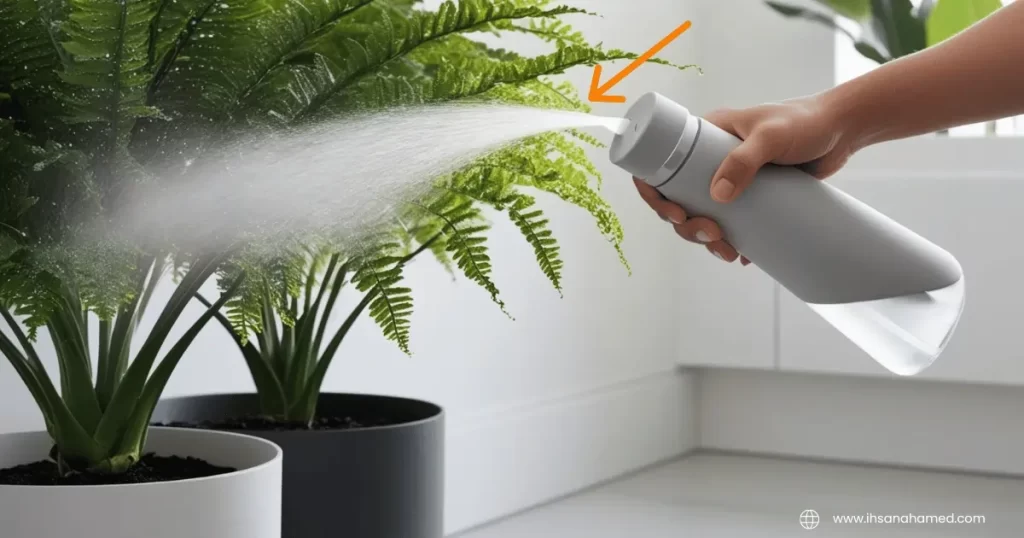
- Use a spray bottle to mist the leaves.
- It’s best to mist in the morning so the water can dry during the daytime.
Misting is like giving your plant a gentle shower, helping it stay fresh and vibrant, especially in dry climates.
By following these simple steps, you can keep your indoor plants healthy and happy. Remember, every plant is unique, so keep an eye on how you react.
4. Setting Up Your Watering Schedule
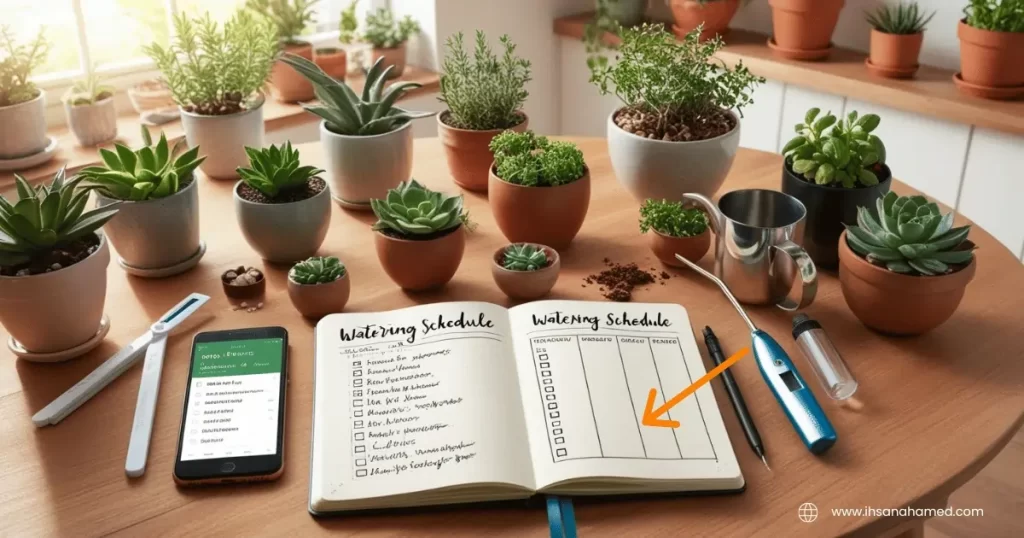
Create a successful watering schedule for your indoor plants to keep them healthy and stronger. But you need to know how often you should water a plant and how to set a plant to work for them.
Every Plant is unique, all plants do not require the same amount of water, you need a few criteria for how often should water the plants.
Plant Type: Some plants, like succulents, need less water, while others, like ferns, need more.
Size of the Pot: Small pots dry out faster than large ones, so you might need to water small pots more often.
Warm and dry temperatures make the soil dry and cooling temperatures hold the moisture level longer.
By paying attention to these factors, you can better understand what plants need.
Making Your Watering Plan
Once you know what affects your plant’s needs and create a watering schedule based on your needs

Water your plants on the same day of each week to have a routine habit. For example, every Saturday morning could be a watering time for specific plants.
Use the finger test to check if the soil is dry or wet. If it is still wet wait for one or two days
This plan gives you a rough idea of when to water but remember, you can adjust a plan based on plant needs.
Changing With the Seasons
The watering schedule may vary depending upon the change of the season.
Plants need less watering or stop watering in winter. Feed them more during the growing season check the soil and feed them always.
As the weather is warm it needs more water during summer and checks the soil often and adjusts the schedule.
5. Avoid These Watering Mistakes
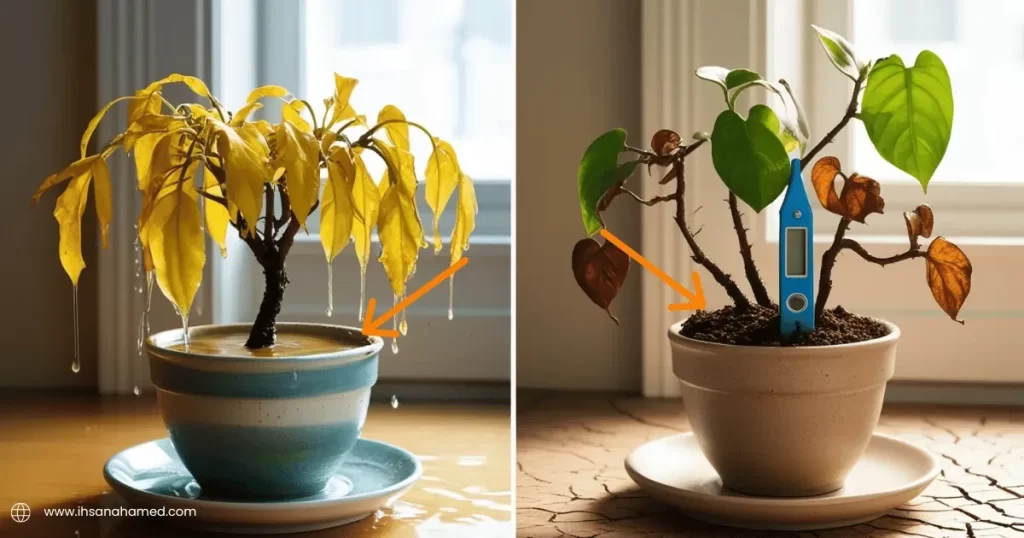
Watering indoor container vegetables seems simple, but it’s easy to make mistakes. Let’s talk about common watering problems, how to spot them, and why the quality of your water is important.
Signs of Overwatering
Overwatering is one of the most common mistakes in indoor gardening. Here’s how to tell if you’re giving your plants too much water:
- If your plant’s leaves are yellow, it might be due to overwatering.
- It seems odd but plants can wilt from overwatering. The roots can’t get oxygen due to the soil being too wet.
- If you see soft and mushy roots when repotting, it’s a sign of overwatering.
To prevent overwatering, always check the soil moisture with your finger or test kit before adding extra watering.
Spotting Under Watered Plants
Underwatering may harm your plants and here is a practical guideline to know your plants need more water and it’s not enough.

- If the leaves feel dry then your plant is thirsty and needs more water.
- Plants become wilt if they are underwatered because they don’t get enough water to keep their structure.
- The tips of the leaves may turn yellow and your plant isn’t getting enough water. If you notice these signs, check the soil and water them.
Why Water Quality Matters
The quality of water may affect your plants
Tap water contains chlorine and other chemicals that can harm your plants. Tap water can also be used in a situation if it is kept idle for 24 hours or use a filtered water.
Distilled water is free from chemicals and minerals and it is a better choice for most plants.
Collecting rainwater and using it for watering a plant. It’s a great option in my opinion, it is natural and chemical-free.
6. Watering Tips for Popular Indoor Veggies

When growing vegetables indoors, each type of plant has different watering needs. Here’s how to keep some of the most popular indoor veggies happy and hydrated.
Tomatoes and Peppers
Tomatoes and peppers are thirsty plants, but they need a lot of water Here is what you should do
- Keep the soil consistently moist and avoid overwatering. Let the soil dry out before watering again.
- Water deeply to encourage strong root growth. Make sure the water reaches the bottom of the pot.
- Try not to split water on the leaves and it may lead to fungus issues. Water them at the base of the plant.
Leafy Greens and Herbs
lettuce and spinach need more water to keep the soil moist because they have shallow roots. Basil and mint need less water and live in dry conditions.

These plants need slight moisture at all times. Check the soil regularly if it is dry, it’s time for water.
Avoid keeping the soil too water and too much moisture from overwatering and Make sure your pots have good drainage holes.
Root Vegetables
Root vegetables like carrots and radishes need special attention for watering
These plants need a wet moisture level and where the roots are growing. Water them slowly and deeply to reach the roots.
Check the soil moisture often, especially as the roots grow. Dry soil can cause the roots to split and become tough.
If you are growing in a larger container, add a layer of mulch on top of the soil to retain the moisture level.
7. Smart Watering for Indoor Gardening

Watering your indoor garden the right way can make your plants thrive. Let’s look at some simple tips to help you water smartly.
Grouping Plants by Water Needs
Different plants need different amounts of water and it is based on plant needs.
- Group plants together like ferns that need a lot of water.
- Keep succulents and cacti together since they don’t need much water.
- Plants like tomatoes need a moderate amount of watering, so group them.
- By keeping plants that have similar needs, you can water them more efficiently.
Watering Vertical Gardens
Vertical gardens have a great layout and it can be tricky to water. Start watering at the top so the water can go deep into the plant roots. A drip system can help all plants get enough water.

Plants at the top of a vertical garden can dry out faster, so check their soil regularly and water them.
Organic Watering Methods
Using organic methods can improve how you water your plants
Add a layer of mulch on top of the soil to help it moisturize longer.
Composting: Mix compost into your soil. It helps the soil hold water better, so you don’t have to water them often.
Use Rainwater: If you can, collect rainwater to use on your plants. It’s better than tap water and free from chemicals.
By using these easy watering tips, you can help your indoor plants grow healthy and strong.
Conclusion
We’ve covered key important tips from the right way for watering indoor container vegetables and fixing Indoor container gardening problems. Remember watering indoor veggies is about experimenting and learning.
With these tips, you’re ready to grow an indoor vegetable garden throughout the year that will impress everyone. So, water your plants with confidence, free from pest control, and keep growing.
How often should I water my indoor plants?

As part of indoor gardening basics, most indoor plants need watering once a week. However, this varies based on plant type, pot size, and your home’s humidity. Check the soil, if the top inch feels dry, it’s time to water.
How much water do indoor plants need?

It varies by plant type, but a good rule of thumb is to water until the soil is moist but not soggy. For most plants, water until you see it draining from the bottom of the pot, which ensures even distribution.
What are the best tools for watering indoor plants?

Using a small, long-spout watering can help deliver water directly to the plant’s roots, avoiding over-watering or splashing on leaves. A moisture meter is essential to check soil moisture levels, ensuring plants get the right amount of water.
How can I avoid overwatering my indoor plants?
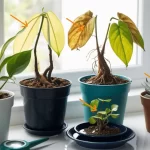
Always check the soil moisture before watering to avoid over-watering, which can harm plants. Using a moisture meter can help ensure the soil is neither too dry nor too wet. Make sure your pots have drainage holes to allow excess water to escape, preventing waterlogging. Proper drainage is crucial to maintaining healthy roots and preventing root rot in indoor plants.
Should I mist my indoor plants?

Misting helps increase humidity, which some tropical plants love. However, it shouldn’t replace regular watering, and not all plants need misting and research your plant’s specific needs.
